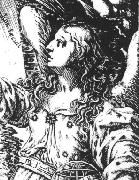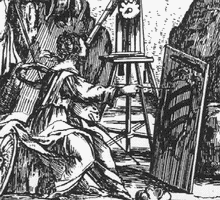

Almagestum Novum astronomiam veterem novamque complectens.
Bononiae, ex typographia haeredis Victorij Benatij, 1651.
pp. [12], XLVII, 763, ill. f°.
DC - f° - 18
Lalande
 Although she presents some of Urania's typical attributes (the starred gown, the
belt with the constellations, the armillary sphere) the young woman appearing
in the frontispiece of the
Almagestum Novum by the jesuit
Giovanni Battista Riccioli is not the Muse of astronomy.
Although she presents some of Urania's typical attributes (the starred gown, the
belt with the constellations, the armillary sphere) the young woman appearing
in the frontispiece of the
Almagestum Novum by the jesuit
Giovanni Battista Riccioli is not the Muse of astronomy.
The author himself, in the dedicatory epistle, explains the complex allegory of the astronomical knowledge of his times: on the left stands Argus, his body covered with one hundred eyes, holding a telescope in order to observe the sky. The ocular of the instrument is placed over Argus' knee, where an eye opens, to mean that the scientist should always kneel down in the presence of God and keep a reverent attitude. The woman on the right is Astraea, mythological deity also known as Dike, goddess of Justice, whose name will be given to the celestial Venus. She holds a balance and weighs two cosmological systems, the Copernican one and the system by Riccioli himself. The latter is epitomized by the putti overlooking the engraving, those in the top left corner holding Venus, Mars and Mercury with the Sun (since they are considered its satellites); those in the top right corner hold Jupiter, Saturn and the Moon, that rotate around the Earth together with the Sun. On the ground Ptolemy holds his system and the coat of arms of the Grimaldi family, to which the work is dedicated.
The engraving is signed by Francesco Curti (Bologna 1603-1670), probably pupil of Guercino, who reproduced various works by the Carracci, Guido Reni and Calvaert.
Giovanni Battista Riccioli (Ferrara 1598-1671), although he understood the depth of Copernicus' work, was a convinced supporter of the Ptolemaic system, which he defended in his Apologia contra systema Copernicanum (1699). He taught astronomy at the Jesuit College in Bologna and showed his vaste knowledge in his works of astronomical, geographical and hydrographic subject.
Ephemerides novissimae motuum coelestium ... ad longitudinem Urbis Mutinae gr. 34.5. ex Philippi Lansbergii hypothesibus.
Mutinae, Andrea Cassiani, 1662.
pp. [24], 220, ill. f°.
DC - f° - 26
Riccardi
 An echo of Urania can be seen in the
frontispiece of the Ephemerides by
marquis Cornelio Malvasia: the deeply allegorical engraving shows a young
woman observing Jupiter with a telescope while she paints a coat of arms,
putting en abyme the stripes of the planet. In fact in the dedicatory
epistle to cardinal Giulio Sacchetti (whose portrait appears on the top of the
frontispiece) the author explains that, during his observations, he had observed
that the Sacchetti coat of arms is striped like Jupiter, whence a supposed
origin of the family from the planet, in honour of the cardinal. In the
frontispiece the young woman eventually depicts a coat of arms, with three
stripes that go in the reverse direction of those of planet
Jupiter, visible in the sky. As a matter of fact, the coat of arms of the
Sacchetti family as established by the heraldic sources presents stripes that
go in the opposite direction of those depicted by the young lady in the
engraving.
An echo of Urania can be seen in the
frontispiece of the Ephemerides by
marquis Cornelio Malvasia: the deeply allegorical engraving shows a young
woman observing Jupiter with a telescope while she paints a coat of arms,
putting en abyme the stripes of the planet. In fact in the dedicatory
epistle to cardinal Giulio Sacchetti (whose portrait appears on the top of the
frontispiece) the author explains that, during his observations, he had observed
that the Sacchetti coat of arms is striped like Jupiter, whence a supposed
origin of the family from the planet, in honour of the cardinal. In the
frontispiece the young woman eventually depicts a coat of arms, with three
stripes that go in the reverse direction of those of planet
Jupiter, visible in the sky. As a matter of fact, the coat of arms of the
Sacchetti family as established by the heraldic sources presents stripes that
go in the opposite direction of those depicted by the young lady in the
engraving. The engraving is by Francesco Stringa (Modena 1635-1708), a portrait painter from the school of Guercino, who was the favourite artist at the court of the Estensi; his activity as engraver is less famous, but not less relevant: among the four engravings he has left, one is this astronomical frontispiece.
Cornelio Malvasia (Bologna 1603-1664) made his astronomical observations in the private observatory he built over his villa in Panzano, near Modena, where he had among his collaborators the main astronomers of the time, such as the modenese Geminiano Montanari. Malvasia was also interested in astrology, but this did not interfere in his appreciation of Montanari's astronomical activity and in the understanding of the young talent of Gian Domenico Cassini, whom he recommended for the chair of astronomy at Bologna University, that he eventually obtained in 1650.



| Biblioteca del Dipartimento di Astronomia Pierluigi Battistini, Laura Peperoni e Marina Zuccoli |